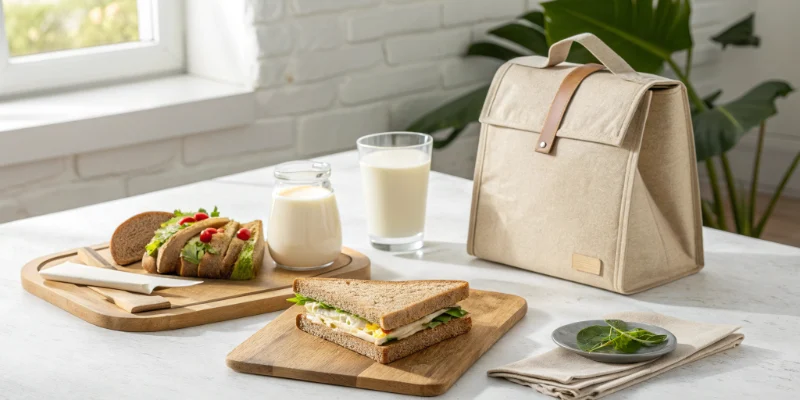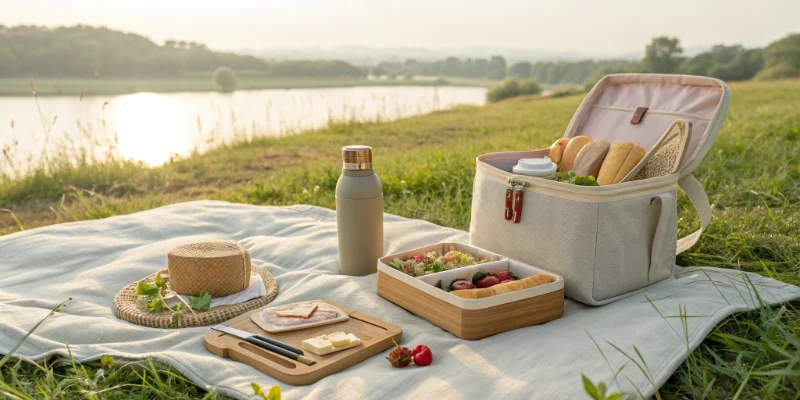Our Academy

When choosing packaging bags, whether for food delivery, brand promotions, or as custom gift packaging, many businesses face the same problem: can one bag provide insulation, convenience, and brand presentation all at once? Traditional plastic bags tend to look cheap, while hard containers are bulky and expensive. The ideal solution often struggles to strike a balance between functionality and budget.
What Is a Cooler Bag? And Why Is It Becoming More Popular Across Different Scenarios? A Cooler Bag is a portable bag with an insulating function, often made of multiple layers of material, including an insulating core, a waterproof lining, and a print-friendly outer fabric, which can maintain the cold or hot temperature of food or drinks for a short period. It can be used for food delivery and cold chain distribution, and is also suitable for brand promotions, event giveaways, and short-trip carrying needs, combining functionality, portability, and visual display value. Compared to traditional plastic bags or hard-sided coolers, the Cooler Bag strikes a better balance between cost, ease of use, and customization options, making it a common packaging solution for businesses in a variety of applications.
Although the functions and common uses of a Cooler Bag have been briefly introduced, a deeper understanding of its structural principles, material differences, and performance in various usage scenarios will help you determine if it truly meets your business needs. Continue reading, and we will guide you through everything from design details to purchasing advice, giving you a comprehensive look at this packaging option that combines both practical and brand value.
A Cooler Bag is a portable, soft-sided bag with insulation, often used for keeping food and drinks cold or hot for a short time. Compared to traditional hard-shell coolers, it is lighter and softer, making it easy to carry for outings or use as gift packaging. Depending on the thickness of its structure and the lining material, its insulation time and usage scenarios can also vary.
Generally, a Cooler Bag is made of three layers of material. The outermost layer is for appearance and support, with common materials including non-woven fabric, Oxford cloth, laminated fabric, PVC, and Tyvek. The material can be chosen to match the budget and purpose. The middle layer is foam, which is responsible for insulation and is key to the bag’s performance. The innermost layer is a waterproof material, often PEVA, PVC, or aluminum foil. It not only prevents leaks but is also very easy to clean.
This multi-layer design makes the Cooler Bag both practical for insulation and convenient for daily carrying and repeated use.
Actually, both are nearly identical in structure and insulation principle, and are often treated as the same product. A Cooler Bag is generally used for keeping things cold, like drinks or deli foods, while a Thermal Bag is more often used for keeping things warm, like lunch boxes or hot takeout. The difference in their names is more about their use case than any real structural difference.
What really affects the insulation performance is the bag’s thickness, its sealing method, and whether it is used with ice packs or hot packs. Generally, the insulation time for keeping items hot or cold is between 2 to 6 hours.

Cooler bags can be used for both hot and cold items. True
Cooler bags use insulated layers that help maintain food or beverage temperature in both directions—hot or cold—for a short period.
Cooler bags are always made with the same inner lining. False
Inner linings vary—PEVA, PVC, aluminum foil—depending on the desired waterproofing, oil resistance, and food safety level.
A Cooler Bag keeps food and drinks at the right temperature because its multiple layers work together. The middle layer is usually made of a foam material (like EPE or EVA), which slows down heat transfer by trapping air. The inner aluminum film layer reflects
thermal radiation1, reducing heat loss or the impact of external heat sources. This “insulation + reflection” combination works for both keeping things cold and keeping them warm for short periods, giving the bag the ability to control temperature for various needs.
Materials are just the foundation; what truly determines the effectiveness is the overall structural design of the bag. A good seal (like a zipper) effectively blocks air exchange between the inside and outside, making it better for long-term cooling or heating than a Velcro closure. The thicker the foam, the better the insulation, but this will also increase the cost and shipping volume. The size of the bag and the space inside also affect how well it maintains temperature—too much empty space speeds up heat exchange, which is not good for insulation.
Yes. A Cooler Bag itself doesn’t “cool” or “heat”; its job is to help you slow down temperature changes. If you want to keep items cold or hot for a long time, it’s recommended to use them with ice packs or hot packs. For example, with common specifications: hot food can be kept warm for 2–4 hours without a hot pack, and this can be extended to 4–6 hours with a heat source. Cold food can stay cool for about 2–4 hours without an ice pack, and this can be extended to 6–8 hours with one. Pre-heating or pre-chilling the bag before use and reducing how often you open it also helps to stabilize the internal temperature.
Curious about how insulated lunch bags really keep food hot or cold? Explore our full breakdown here: Insulated Lunch Bags: The Secret to Keeping Food Hot or Cold
For food and beverage businesses, a Cooler Bag is a practical tool for daily hot food delivery. It helps maintain the temperature and integrity of items like bento boxes, fried rice, and soups before they are delivered. Compared to disposable bags or hard-sided insulated boxes, these soft-structured bags are lighter and easier to store and use in bulk. Many food delivery brands choose to customize them with their LOGO to enhance brand recognition.
Whether it’s for a weekend outing or outdoor camping, a Cooler Bag that can keep things cold is an essential item. It can hold drinks, sandwiches, fruits, or barbecue ingredients, keeping them fresh for several hours in an environment without a refrigerator. If you put an ice pack in it beforehand, you can extend the cooling time, allowing you to easily enjoy a “cold drinks + snacks” combo even when you’re out in the country.

When buying items that need to be refrigerated for a short time, like frozen foods, fresh meat, or dairy products, a Cooler Bag can be used as a temporary transport bag to prevent spoilage due to high temperatures. It is especially suitable for consumers with a long drive or those who don’t have an insulated shopping box. It can also be used with small ice packs commonly available at supermarkets.
Many office workers or students use a small Cooler Bag to carry their homemade lunches. Not only does it offer better insulation, but it also prevents food odors from leaking out. Some styles also have internal mesh pockets or dividers, making it convenient to separate utensils, sauces, or fruit. They are highly practical, and their appearance is more suitable for daily commuting.
Cooler Bags are also often used as promotional giveaway bags by businesses, especially for events hosted by food, beverage, or health-related brands. By customizing the size, color, and LOGO, they not only increase brand exposure but also offer high advertising value due to their practicality and high reusability. Compared to regular tote bags, these insulated bags also have a higher perceived value, which can better enhance user favorability.
Soft cooler bags can be used for both hot and cold items. True
Soft cooler bags with proper insulation materials like EPE foam or aluminum foil lining can help maintain the temperature of both hot and cold items for short periods.
Soft cooler bags are not durable enough for regular use. False
Soft cooler bags made with thick oxford fabric or laminated materials can be highly durable and suitable for repeated daily use, especially with reinforced stitching and linings.
The main function of a Cooler Bag is to slow down the temperature change of food and drinks. Without using extra ice packs or hot packs, the warming/cooling time for hot food or cold drinks is generally 2–4 hours. This time frame is suitable for daily commutes, food delivery, and short shopping trips. When used with aids, the insulation time can be significantly extended.
How well a bag insulates is closely related to the following four points:
| Influencing Factor | Description |
|---|---|
| Bag Structure | A Cooler Bag with more layers and a thicker middle layer (like thickened foam) will keep items insulated for longer. |
| Sealing Method | A high-seal zipper closure locks in temperature better than Velcro or an open-top design. |
| Use of Ice/Hot Packs | Using cold sources like ice packs or heat sources like hot water bottles can extend the insulation time to 6–8 hours or more. |
| Usage Habits and Environment | Pre-heating/pre-chilling the bag, opening it less frequently, and avoiding direct sunlight can all improve overall insulation efficiency. |
These factors can be adjusted flexibly. It is recommended to choose a configuration that meets your actual needs.
A Cooler Bag is a lighter “short-term insulation tool” and cannot replace the all-day, long-term cooling function of a hard-shell cooler. It is suitable for temporary insulation needs of up to about 6–8 hours, such as for lunch delivery, takeout packaging, or outdoor gatherings. If you need to keep items refrigerated for more than half a day or transport cold-chain products, it is recommended to choose a cooler box with ice bricks or an electric cooling device.
In short, a Cooler Bag is more like a “daily insulation partner.” The key is to choose the right style and use it with the right accessories to ensure it performs well where it’s needed.

The outer material of a Cooler Bag determines its overall look and feel, load-bearing strength, and whether it can be used repeatedly. Different materials are suitable for different purposes—some are lightweight and ideal for promotions, some are sturdy and durable for daily lunches or food transport, while others emphasize an eco-friendly look or unique texture. Here are a few common outer materials and their basic characteristics:
| Material Type | Material Characteristics |
|---|---|
| Non-Woven Fabric | Lightweight and low-cost, suitable for large-volume orders, ideal for single-use or short-term scenarios. |
| Polyester / Oxford Cloth | Strong and durable with a well-defined structure, suitable for carrying weight and repeated daily use, with a more professional overall texture. |
| Cotton / Canvas | A natural material that is eco-friendly and durable, with a natural appearance, suitable for brands focusing on a sustainable image. |
| Laminated Non-Woven Fabric / Oxford Cloth | Has a glossy or matte film on the surface, is waterproof and easy to clean, and supports large-area pattern designs. |
| Tyvek (DuPont Paper) | Lightweight and tear-resistant with a unique paper-like feel. Lamination increases its stiffness, often used for eco-friendly or creative products. |
| Washable Kraft Paper | Has a natural texture with a slightly retro feel and a unique appearance. The texture varies slightly in each batch, suitable for creating brand differentiation. |
Curious about which outer material works best for cooler bags? Explore our full comparison here: Top 6 Outer Materials for Custom Cooler Bags: Pros, Styles & Use Cases
The middle insulation layer of a Cooler Bag is key to its overall performance. It mainly uses a foam structure combined with different linings to form an integrated layer. Different combinations vary in insulation effect, durability, and suitable applications, depending on the material’s thermal conductivity2. Here are some common structures:
| Material Structure Combination | Material Characteristics |
|---|---|
| EPE Foam + Smooth Aluminum Foil | The most common standard structure, providing basic insulation and cushioning, suitable for promotional bags or daily lunch bags. |
| EPE Foam + Diamond-Patterned Aluminum Foil | The aluminum film has an embossed design, is thicker, and enhances overall durability. Suitable for mid-range reusable insulated bags. |
| PE Foam + Snowflake Aluminum Film | A thicker structure with better insulation, often used for high-end cooler bags or for long-duration outdoor needs. |
| PE Foam + PEVA / PVC Lining | If stronger waterproof or oil-resistant properties are needed, it can be paired with a food-grade lining to enhance practicality and ease of cleaning. |
Besides the material itself, the structural design of a Cooler Bag is also very important:

Cooler bags can be made from sustainable or recycled materials. True
Materials like RPET, cotton, and washable kraft paper are commonly used in eco-friendly cooler bags for sustainable branding purposes.
All cooler bags are leakproof by default. False
Not all cooler bags are leakproof. Only those with heat-pressed PEVA or PVC linings and no stitched seams offer high anti-leakage performance.
The reason Cooler Bags have become widely used in dining, promotions, and personal and corporate settings in recent years is that they strike an excellent balance between cost, function, and brand display. They are not as bulky and expensive as traditional hard-sided coolers, and they offer more reuse value and visual appeal than single-use plastic bags. Whether for short-term preservation, enhancing brand favorability, or as a convenient gift solution, the Cooler Bag provides a flexible and practical option. This simple yet highly practical design is the key reason for its rapid popularity in a diverse market.
As a professional cooler bag manufacturer, Yanxin Bag offers custom cooler bag services with a variety of bag types, materials, and printing methods, suitable for all kinds of commercial uses such as promotional gifts, food and beverage delivery, and e-commerce packaging. We support on-demand sampling and bulk customization with flexible MOQ and efficient production.
If you are looking for a reliable manufacturer, please feel free to contact us. We will provide suitable custom recommendations and a price quote based on your needs.
Curious how insulation really works inside a lunch bag?
This article breaks down the structure of insulated lunch bags layer by layer — covering outer materials, inner linings, core insulation, and zipper sealing — to explain how each part contributes to temperature control.
Planning to customize a cooler bag for your brand?
This article highlights essential considerations when customizing a cooler bag, including capacity, structural design, materials, printing needs, manufacturing processes, and supplier capabilities.
Want to extend how long your food stays warm?
This article explains the factors that affect heat retention in insulated bags — such as sealing, structural design, food packaging, volume, and material — and offers ways to improve their performance.
Not sure how to use a cooler bag for best results?
This guide provides step-by-step instructions on how to prepare your bag and contents before heading out, how to pack efficiently, and tips for keeping the bag cold while on the go.
Looking for practical ways to use an insulated bag?
This article lists versatile use cases for insulated bags across daily routines, travel, and specialized scenarios — from grocery cooling and picnic storage to medical transport and emergency supplies.
Get a free quote and expert consultation today. Let's bring your brand vision to life.
Answer: Soft cooler bags are lightweight, foldable, and easy to carry. They offer short-term insulation and are ideal for daily lunch packing, picnics, and promotional use.
Answer: Soft cooler bags typically have a shorter insulation time (2–6 hours), lower structural durability under heavy loads, and may be less effective in extreme environments.
Answer: Yes, most reusable cooler bags are made from durable materials like nonwoven fabric, canvas, or RPET, making them environmentally friendly alternatives to single-use plastic bags.
Answer: Hard coolers offer longer cooling duration and more structural strength, while soft cooler bags provide better portability and branding flexibility.
Answer: It’s recommended to use ice packs or sealed ice containers to prevent leaks, unless the cooler bag has a heat-sealed PEVA or PVC lining.
Answer: Soft cooler bags are more portable and customizable, while hard cooler boxes are rigid, offer longer ice retention, and are better for extended outdoor use.
Answer: The best insulation materials for reusable insulated cooler bags include EPE foam combined with aluminum foil, PE foam with snowflake aluminum layers, and multi-layer designs with PEVA or PVC linings for enhanced waterproofing. These structures provide effective temperature control for both hot and cold storage.
Answer: To clean reusable cooler bags, wipe the inner lining with a damp cloth or mild detergent. PEVA and PVC linings are easy to maintain due to their waterproof surfaces. Avoid machine washing unless specified. Proper care extends the life of custom cooler bags and maintains their insulation performance.
Answer: Cooler bags can maintain temperature for a short time without ice packs, but for optimal insulation performance, using ice packs is strongly recommended.

Order or no-order we are Always here to help you!
We will contact you within 1 working day, please pay attention to the email with the suffix “@yanxinbag.com”.
Order or no-order we are Always here to help you!
We will contact you within 1 working day, please pay attention to the email with the suffix “@yanxinbag.com”.